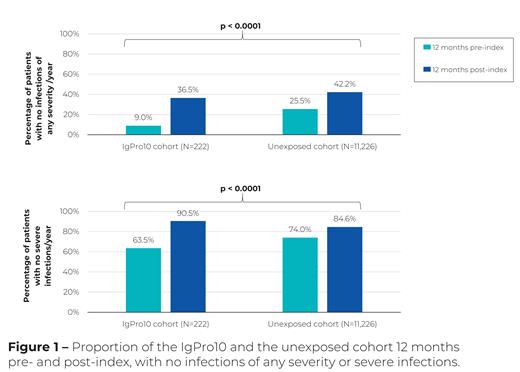Abstract

Secondary immunodeficiency (SID) is an acquired condition caused by several factors including, but not limited to, B-cell malignancies, and may result in frequent, burdensome, and possibly life-threatening infections. Treatment guidelines recommend immunoglobulin replacement therapy (IgRT) in certain settings to prevent recurrent, persistent, or major (severe) infections. This retrospective analysis of a US healthcare database characterized patients (pts) with suspected SID, who experienced infections, and were or were not treated with IgRT (IgPro10 [Privigen ®]).
Data were collected from 26 US healthcare organizations from TriNetX DataWorks™ Network between 1/1/09 - 1/31/20. Pts were required to have the following: suspected SID (defined as ≥1 underlying conditions related to SID such as: solid organ transplant [SOT], non-Hodgkin lymphoma [NHL], multiple myeloma [MM], and chronic lymphocytic leukemia [CLL]), ≥1 severe infection (defined as requiring hospitalization and/or treatment with intravenous antibiotics or anti-viral medication) or ≥2 non-severe infections between underlying condition diagnosis date and the index date, the absence of diagnosed primary immunodeficiency, and an available medical history of ≥12 months pre-index and ≥3 months post-index. The index date refers to first IgPro10 use or the corresponding date for pts not receiving IgPro10 (unexposed cohort). In the IgPro10 cohort, pts were required to have had ≥2 consecutive IgPro10 administrations within 90 days. Between the pre- and post-index periods, the following variables were compared for both cohorts: pts' treatment, underlying conditions, baseline characteristics, and change in annualized infection rate (for infections of any severity and severe infections). Pre-index immunoglobulin G (IgG) (or calculated globulin [CG]) levels were recorded as: hypogammaglobulinemia (HGG) (IgG <6 g/L or CG <18 g/L), normal (IgG ≥6 g/L or CG ≥18 g/L), or missing. A generalized estimation equation (GEE) model with logit link was used to compare the change in the proportion of pts with an annualized infection rate of zero from the pre- to the post-index period across both cohorts.
The final sample comprised 222 IgPro10 pts and 11,226 unexposed pts. In the IgPro10 cohort, 143 pts were on IgPro10 for <6 months, 41 pts for 6-12 months, and 38 pts for >12 months. In both the IgPro10 and the unexposed cohorts, SOT was the most frequent underlying condition (45.5% and 44.6%, respectively), followed by NHL (21.6% and 28.2%, respectively), MM (14.4% and 10.1%, respectively), and CLL (11.3% and 7.6%, respectively). Age (mean [SD], 57.2 [13.9] vs 57.9 [17.0] years old, respectively) and sex distribution (male:female, 56.3%:43.7% vs 51%:48.8%, respectively) were similar in the IgPro10 and unexposed cohort. During the pre-index period, the IgPro10 cohort, compared with the unexposed cohort, received a greater number of antibiotic courses (median [interquartile range], 7 [20] vs 1 [5], respectively), had a substantially higher proportion of pts with HGG (HGG: 34.7% vs 3.0%; normal IgG: 43.7% vs 57.8%; missing: 21.6% vs 39.2%, respectively), and a lower proportion of pts with an annualized infection rate of zero (for infections of any severity and severe infections) (Figure 1). There was an approximate four-fold increase in the proportion of pts with no infections of any severity following IgPro10 administration; this increase was significantly larger than in the unexposed cohort (p<0.0001) (Figure 1). Additionally, there was an increase in the proportion of pts with no severe infections following IgPro10 administration. Again, this increase was significantly larger than in the unexposed cohort (p<0.0001) (Figure 1).
This real-world study found that compared with pts not receiving IgRT, pts who subsequently went on to receive IgPro10 experienced more infections pre-treatment. Following IgPro10 administration, more pts had an annualized infection rate of zero (for infections of any severity or severe infections) compared with the pre-index period. Moreover, the increase in the proportion of pts with no infections was greater in the IgPro10 cohort than in the unexposed cohort, for both infections of any severity and severe infections. Taken together, these findings suggest effectiveness of IgPro10 in pts with SID, but further study, such as a prospective randomized controlled trial, is needed to confirm these initial findings.
Lahue: CSL Behring: Consultancy; Alkemi Health: Current Employment, Current holder of stock options in a privately-held company. Mallick: CSL Behring: Current Employment, Current holder of individual stocks in a privately-held company. Zhang: CSL Behring: Current Employment, Current holder of individual stocks in a privately-held company. Koenig: CSL Behring: Current Employment, Current holder of individual stocks in a privately-held company. Espinoza: CSL Behring: Current Employment, Current holder of individual stocks in a privately-held company.
IgPro10 (Privigen®, CSL Behring, King of Prussia, PA, U.S.), a type of immunoglobulin replacement therapy, is currently approved in the U.S. to treat patients with primary immunodeficiency (PI), chronic inflammatory demyelinating polyneuropathy (CIDP), and chronic immune thrombocytopenic purpura (ITP).
Author notes
 This icon denotes a clinically relevant abstract
This icon denotes a clinically relevant abstract


This feature is available to Subscribers Only
Sign In or Create an Account Close Modal